Analysis of End-of-Life Care for Aboriginal People: A Case Study
VerifiedAdded on 2021/06/16
|6
|1593
|232
Case Study
AI Summary
This case study examines the complexities of end-of-life care for Aboriginal people, focusing on a patient named Tom facing a life-limiting condition. It explores legal and clinical issues arising from conflicting opinions within the family regarding end-of-life decisions, particularly the daughter's desire to alter the 'not resuscitate' (NFR) approach. The paper highlights ethical dilemmas, the importance of clear communication, and the need for family support during the terminal phase. It outlines goals for caregivers, emphasizing the need to address the patient's current condition, and support the family emotionally while adhering to the established palliative care plan. The case study underscores the significance of awareness programs and continuous communication to ensure all family members understand and accept the end-of-life approach.
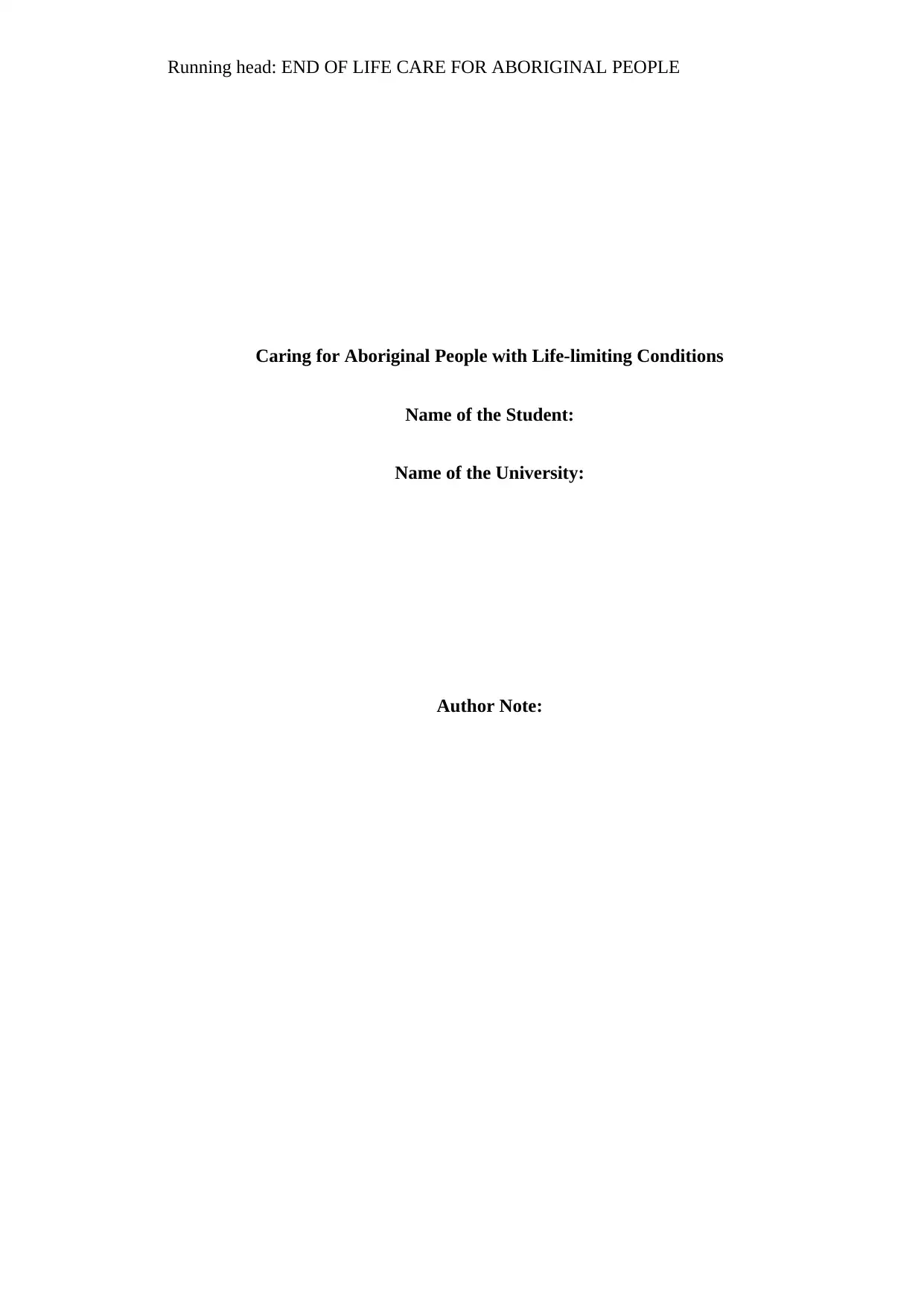
Running head: END OF LIFE CARE FOR ABORIGINAL PEOPLE
Caring for Aboriginal People with Life-limiting Conditions
Name of the Student:
Name of the University:
Author Note:
Caring for Aboriginal People with Life-limiting Conditions
Name of the Student:
Name of the University:
Author Note:
Paraphrase This Document
Need a fresh take? Get an instant paraphrase of this document with our AI Paraphraser
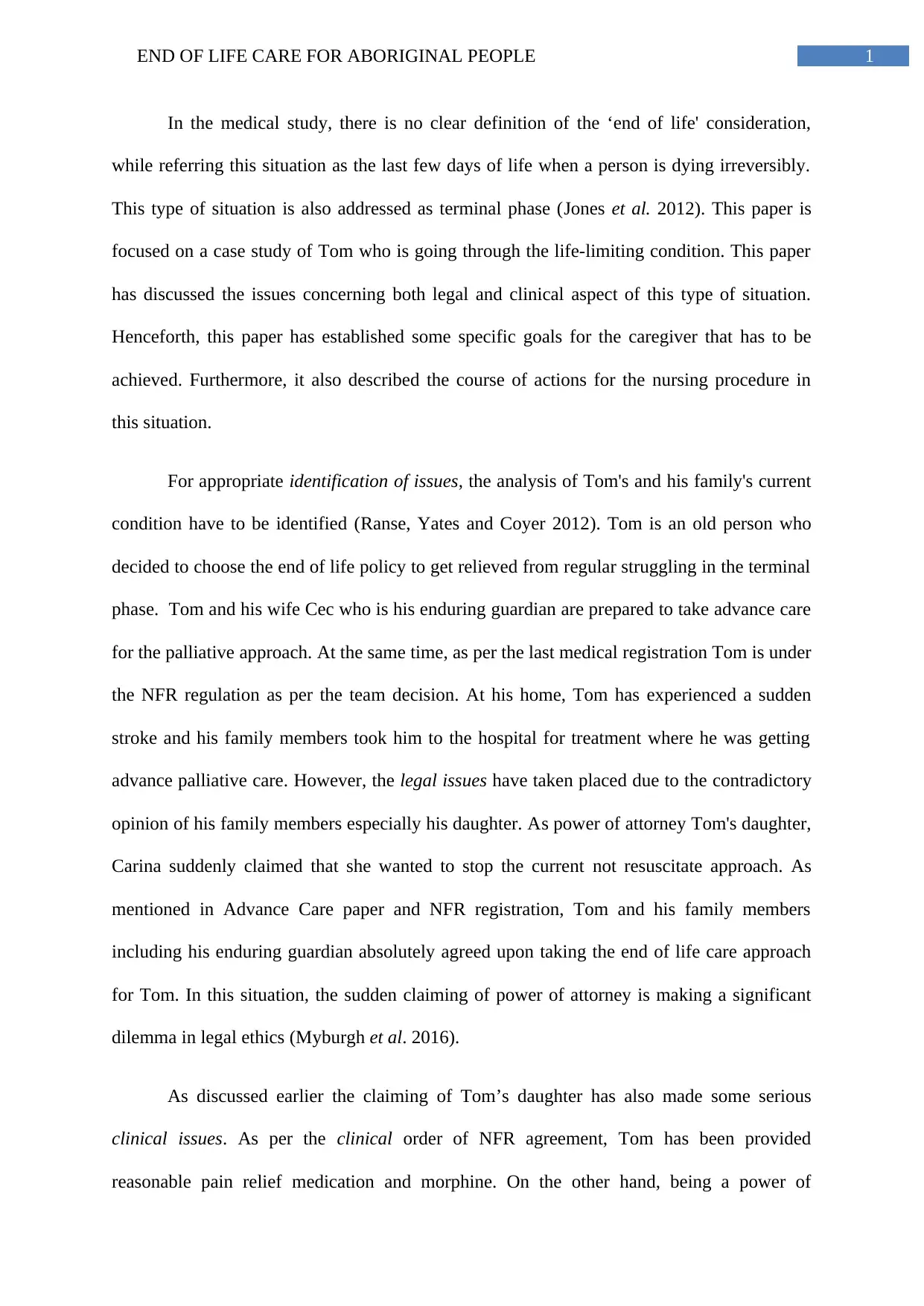
1END OF LIFE CARE FOR ABORIGINAL PEOPLE
In the medical study, there is no clear definition of the ‘end of life' consideration,
while referring this situation as the last few days of life when a person is dying irreversibly.
This type of situation is also addressed as terminal phase (Jones et al. 2012). This paper is
focused on a case study of Tom who is going through the life-limiting condition. This paper
has discussed the issues concerning both legal and clinical aspect of this type of situation.
Henceforth, this paper has established some specific goals for the caregiver that has to be
achieved. Furthermore, it also described the course of actions for the nursing procedure in
this situation.
For appropriate identification of issues, the analysis of Tom's and his family's current
condition have to be identified (Ranse, Yates and Coyer 2012). Tom is an old person who
decided to choose the end of life policy to get relieved from regular struggling in the terminal
phase. Tom and his wife Cec who is his enduring guardian are prepared to take advance care
for the palliative approach. At the same time, as per the last medical registration Tom is under
the NFR regulation as per the team decision. At his home, Tom has experienced a sudden
stroke and his family members took him to the hospital for treatment where he was getting
advance palliative care. However, the legal issues have taken placed due to the contradictory
opinion of his family members especially his daughter. As power of attorney Tom's daughter,
Carina suddenly claimed that she wanted to stop the current not resuscitate approach. As
mentioned in Advance Care paper and NFR registration, Tom and his family members
including his enduring guardian absolutely agreed upon taking the end of life care approach
for Tom. In this situation, the sudden claiming of power of attorney is making a significant
dilemma in legal ethics (Myburgh et al. 2016).
As discussed earlier the claiming of Tom’s daughter has also made some serious
clinical issues. As per the clinical order of NFR agreement, Tom has been provided
reasonable pain relief medication and morphine. On the other hand, being a power of
In the medical study, there is no clear definition of the ‘end of life' consideration,
while referring this situation as the last few days of life when a person is dying irreversibly.
This type of situation is also addressed as terminal phase (Jones et al. 2012). This paper is
focused on a case study of Tom who is going through the life-limiting condition. This paper
has discussed the issues concerning both legal and clinical aspect of this type of situation.
Henceforth, this paper has established some specific goals for the caregiver that has to be
achieved. Furthermore, it also described the course of actions for the nursing procedure in
this situation.
For appropriate identification of issues, the analysis of Tom's and his family's current
condition have to be identified (Ranse, Yates and Coyer 2012). Tom is an old person who
decided to choose the end of life policy to get relieved from regular struggling in the terminal
phase. Tom and his wife Cec who is his enduring guardian are prepared to take advance care
for the palliative approach. At the same time, as per the last medical registration Tom is under
the NFR regulation as per the team decision. At his home, Tom has experienced a sudden
stroke and his family members took him to the hospital for treatment where he was getting
advance palliative care. However, the legal issues have taken placed due to the contradictory
opinion of his family members especially his daughter. As power of attorney Tom's daughter,
Carina suddenly claimed that she wanted to stop the current not resuscitate approach. As
mentioned in Advance Care paper and NFR registration, Tom and his family members
including his enduring guardian absolutely agreed upon taking the end of life care approach
for Tom. In this situation, the sudden claiming of power of attorney is making a significant
dilemma in legal ethics (Myburgh et al. 2016).
As discussed earlier the claiming of Tom’s daughter has also made some serious
clinical issues. As per the clinical order of NFR agreement, Tom has been provided
reasonable pain relief medication and morphine. On the other hand, being a power of
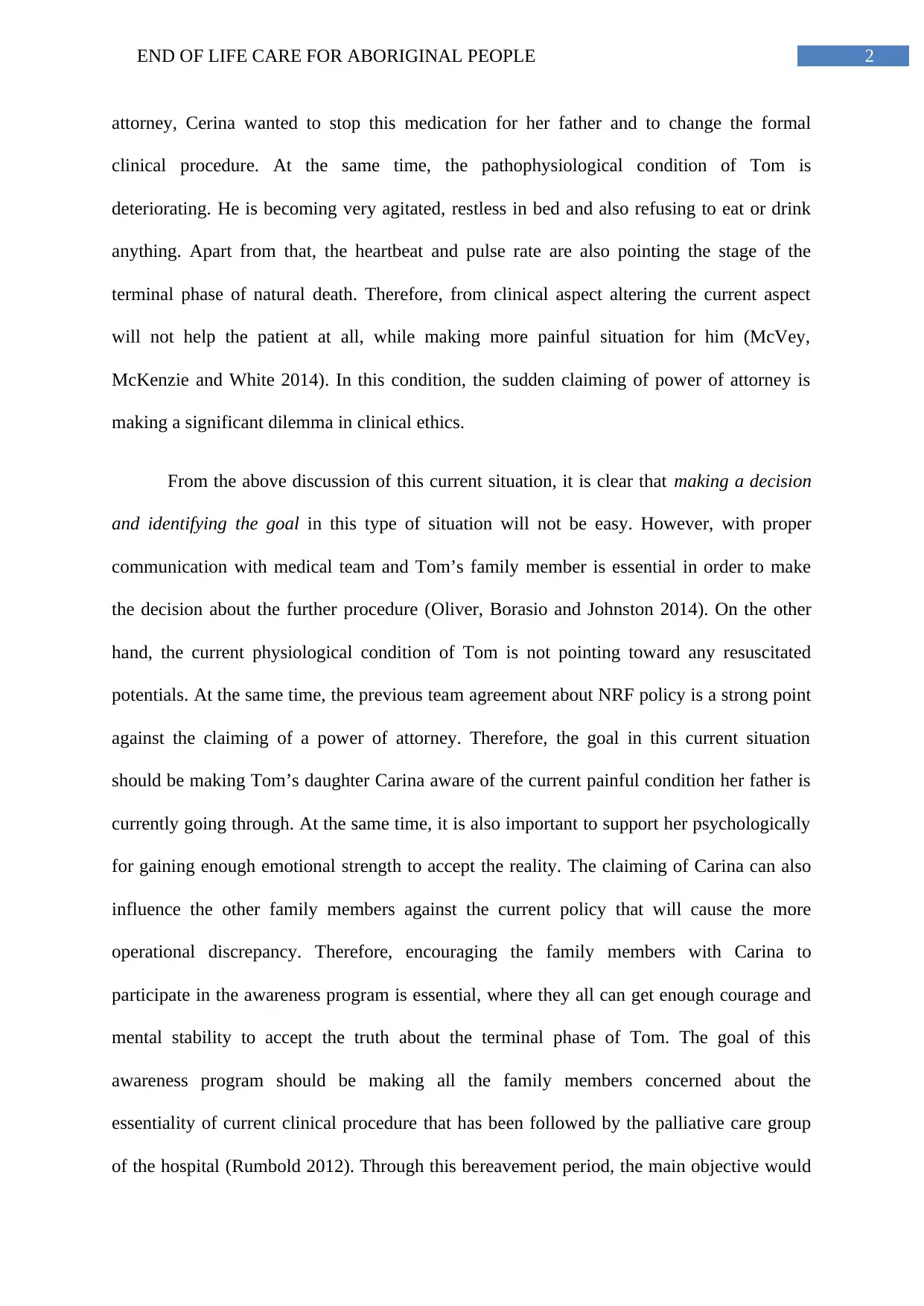
2END OF LIFE CARE FOR ABORIGINAL PEOPLE
attorney, Cerina wanted to stop this medication for her father and to change the formal
clinical procedure. At the same time, the pathophysiological condition of Tom is
deteriorating. He is becoming very agitated, restless in bed and also refusing to eat or drink
anything. Apart from that, the heartbeat and pulse rate are also pointing the stage of the
terminal phase of natural death. Therefore, from clinical aspect altering the current aspect
will not help the patient at all, while making more painful situation for him (McVey,
McKenzie and White 2014). In this condition, the sudden claiming of power of attorney is
making a significant dilemma in clinical ethics.
From the above discussion of this current situation, it is clear that making a decision
and identifying the goal in this type of situation will not be easy. However, with proper
communication with medical team and Tom’s family member is essential in order to make
the decision about the further procedure (Oliver, Borasio and Johnston 2014). On the other
hand, the current physiological condition of Tom is not pointing toward any resuscitated
potentials. At the same time, the previous team agreement about NRF policy is a strong point
against the claiming of a power of attorney. Therefore, the goal in this current situation
should be making Tom’s daughter Carina aware of the current painful condition her father is
currently going through. At the same time, it is also important to support her psychologically
for gaining enough emotional strength to accept the reality. The claiming of Carina can also
influence the other family members against the current policy that will cause the more
operational discrepancy. Therefore, encouraging the family members with Carina to
participate in the awareness program is essential, where they all can get enough courage and
mental stability to accept the truth about the terminal phase of Tom. The goal of this
awareness program should be making all the family members concerned about the
essentiality of current clinical procedure that has been followed by the palliative care group
of the hospital (Rumbold 2012). Through this bereavement period, the main objective would
attorney, Cerina wanted to stop this medication for her father and to change the formal
clinical procedure. At the same time, the pathophysiological condition of Tom is
deteriorating. He is becoming very agitated, restless in bed and also refusing to eat or drink
anything. Apart from that, the heartbeat and pulse rate are also pointing the stage of the
terminal phase of natural death. Therefore, from clinical aspect altering the current aspect
will not help the patient at all, while making more painful situation for him (McVey,
McKenzie and White 2014). In this condition, the sudden claiming of power of attorney is
making a significant dilemma in clinical ethics.
From the above discussion of this current situation, it is clear that making a decision
and identifying the goal in this type of situation will not be easy. However, with proper
communication with medical team and Tom’s family member is essential in order to make
the decision about the further procedure (Oliver, Borasio and Johnston 2014). On the other
hand, the current physiological condition of Tom is not pointing toward any resuscitated
potentials. At the same time, the previous team agreement about NRF policy is a strong point
against the claiming of a power of attorney. Therefore, the goal in this current situation
should be making Tom’s daughter Carina aware of the current painful condition her father is
currently going through. At the same time, it is also important to support her psychologically
for gaining enough emotional strength to accept the reality. The claiming of Carina can also
influence the other family members against the current policy that will cause the more
operational discrepancy. Therefore, encouraging the family members with Carina to
participate in the awareness program is essential, where they all can get enough courage and
mental stability to accept the truth about the terminal phase of Tom. The goal of this
awareness program should be making all the family members concerned about the
essentiality of current clinical procedure that has been followed by the palliative care group
of the hospital (Rumbold 2012). Through this bereavement period, the main objective would
⊘ This is a preview!⊘
Do you want full access?
Subscribe today to unlock all pages.

Trusted by 1+ million students worldwide
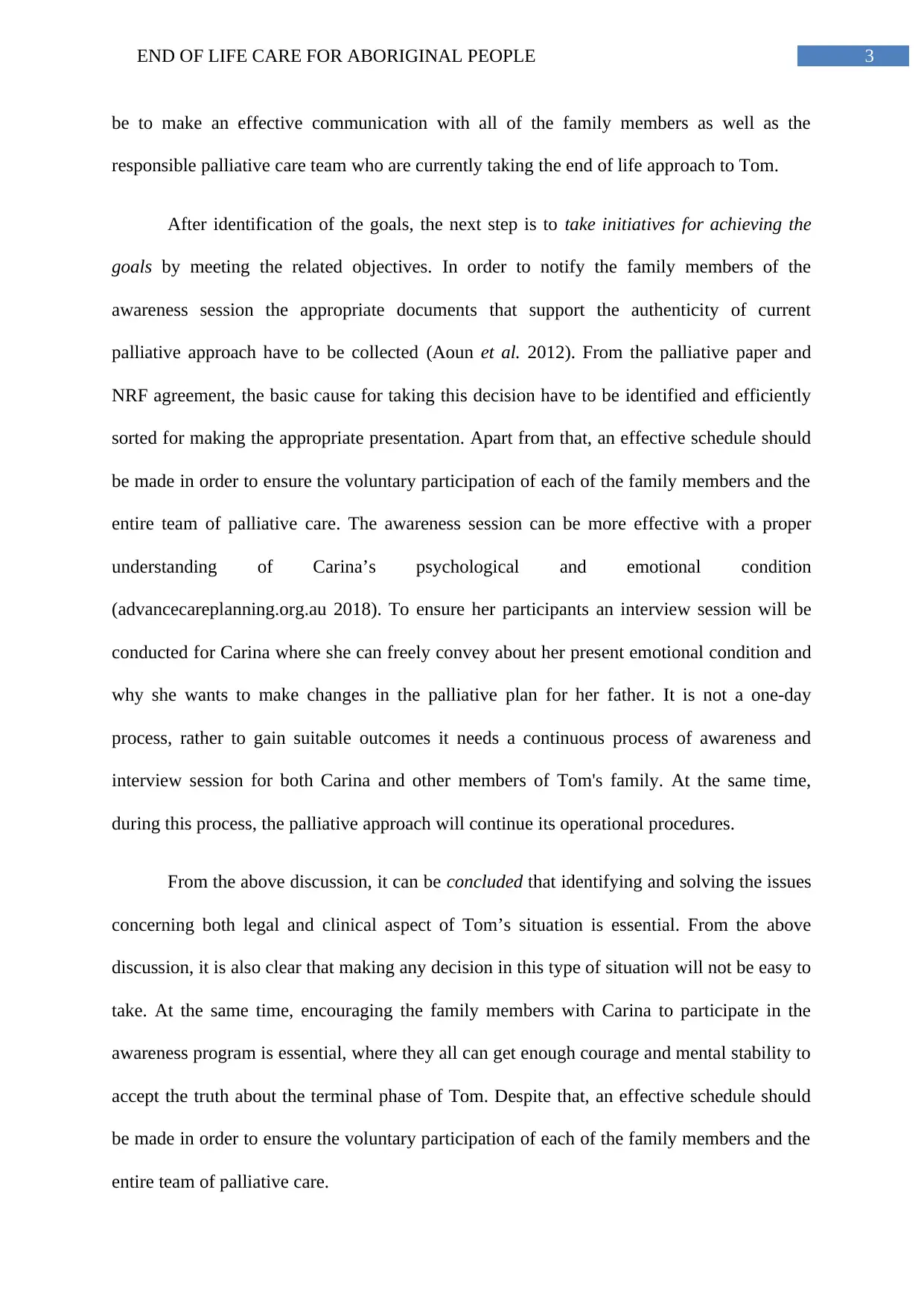
3END OF LIFE CARE FOR ABORIGINAL PEOPLE
be to make an effective communication with all of the family members as well as the
responsible palliative care team who are currently taking the end of life approach to Tom.
After identification of the goals, the next step is to take initiatives for achieving the
goals by meeting the related objectives. In order to notify the family members of the
awareness session the appropriate documents that support the authenticity of current
palliative approach have to be collected (Aoun et al. 2012). From the palliative paper and
NRF agreement, the basic cause for taking this decision have to be identified and efficiently
sorted for making the appropriate presentation. Apart from that, an effective schedule should
be made in order to ensure the voluntary participation of each of the family members and the
entire team of palliative care. The awareness session can be more effective with a proper
understanding of Carina’s psychological and emotional condition
(advancecareplanning.org.au 2018). To ensure her participants an interview session will be
conducted for Carina where she can freely convey about her present emotional condition and
why she wants to make changes in the palliative plan for her father. It is not a one-day
process, rather to gain suitable outcomes it needs a continuous process of awareness and
interview session for both Carina and other members of Tom's family. At the same time,
during this process, the palliative approach will continue its operational procedures.
From the above discussion, it can be concluded that identifying and solving the issues
concerning both legal and clinical aspect of Tom’s situation is essential. From the above
discussion, it is also clear that making any decision in this type of situation will not be easy to
take. At the same time, encouraging the family members with Carina to participate in the
awareness program is essential, where they all can get enough courage and mental stability to
accept the truth about the terminal phase of Tom. Despite that, an effective schedule should
be made in order to ensure the voluntary participation of each of the family members and the
entire team of palliative care.
be to make an effective communication with all of the family members as well as the
responsible palliative care team who are currently taking the end of life approach to Tom.
After identification of the goals, the next step is to take initiatives for achieving the
goals by meeting the related objectives. In order to notify the family members of the
awareness session the appropriate documents that support the authenticity of current
palliative approach have to be collected (Aoun et al. 2012). From the palliative paper and
NRF agreement, the basic cause for taking this decision have to be identified and efficiently
sorted for making the appropriate presentation. Apart from that, an effective schedule should
be made in order to ensure the voluntary participation of each of the family members and the
entire team of palliative care. The awareness session can be more effective with a proper
understanding of Carina’s psychological and emotional condition
(advancecareplanning.org.au 2018). To ensure her participants an interview session will be
conducted for Carina where she can freely convey about her present emotional condition and
why she wants to make changes in the palliative plan for her father. It is not a one-day
process, rather to gain suitable outcomes it needs a continuous process of awareness and
interview session for both Carina and other members of Tom's family. At the same time,
during this process, the palliative approach will continue its operational procedures.
From the above discussion, it can be concluded that identifying and solving the issues
concerning both legal and clinical aspect of Tom’s situation is essential. From the above
discussion, it is also clear that making any decision in this type of situation will not be easy to
take. At the same time, encouraging the family members with Carina to participate in the
awareness program is essential, where they all can get enough courage and mental stability to
accept the truth about the terminal phase of Tom. Despite that, an effective schedule should
be made in order to ensure the voluntary participation of each of the family members and the
entire team of palliative care.
Paraphrase This Document
Need a fresh take? Get an instant paraphrase of this document with our AI Paraphraser
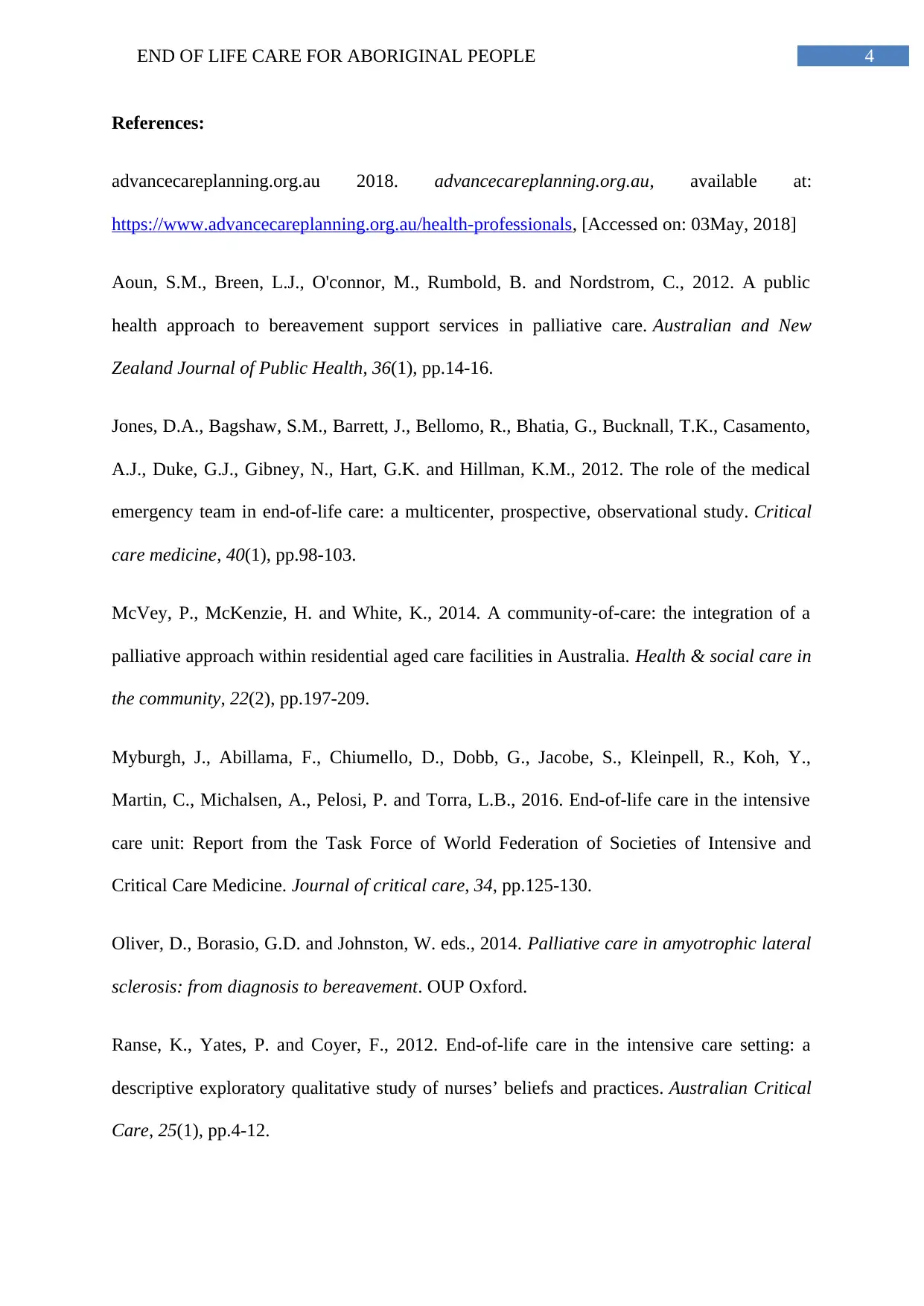
4END OF LIFE CARE FOR ABORIGINAL PEOPLE
References:
advancecareplanning.org.au 2018. advancecareplanning.org.au, available at:
https://www.advancecareplanning.org.au/health-professionals, [Accessed on: 03May, 2018]
Aoun, S.M., Breen, L.J., O'connor, M., Rumbold, B. and Nordstrom, C., 2012. A public
health approach to bereavement support services in palliative care. Australian and New
Zealand Journal of Public Health, 36(1), pp.14-16.
Jones, D.A., Bagshaw, S.M., Barrett, J., Bellomo, R., Bhatia, G., Bucknall, T.K., Casamento,
A.J., Duke, G.J., Gibney, N., Hart, G.K. and Hillman, K.M., 2012. The role of the medical
emergency team in end-of-life care: a multicenter, prospective, observational study. Critical
care medicine, 40(1), pp.98-103.
McVey, P., McKenzie, H. and White, K., 2014. A community‐of‐care: the integration of a
palliative approach within residential aged care facilities in Australia. Health & social care in
the community, 22(2), pp.197-209.
Myburgh, J., Abillama, F., Chiumello, D., Dobb, G., Jacobe, S., Kleinpell, R., Koh, Y.,
Martin, C., Michalsen, A., Pelosi, P. and Torra, L.B., 2016. End-of-life care in the intensive
care unit: Report from the Task Force of World Federation of Societies of Intensive and
Critical Care Medicine. Journal of critical care, 34, pp.125-130.
Oliver, D., Borasio, G.D. and Johnston, W. eds., 2014. Palliative care in amyotrophic lateral
sclerosis: from diagnosis to bereavement. OUP Oxford.
Ranse, K., Yates, P. and Coyer, F., 2012. End-of-life care in the intensive care setting: a
descriptive exploratory qualitative study of nurses’ beliefs and practices. Australian Critical
Care, 25(1), pp.4-12.
References:
advancecareplanning.org.au 2018. advancecareplanning.org.au, available at:
https://www.advancecareplanning.org.au/health-professionals, [Accessed on: 03May, 2018]
Aoun, S.M., Breen, L.J., O'connor, M., Rumbold, B. and Nordstrom, C., 2012. A public
health approach to bereavement support services in palliative care. Australian and New
Zealand Journal of Public Health, 36(1), pp.14-16.
Jones, D.A., Bagshaw, S.M., Barrett, J., Bellomo, R., Bhatia, G., Bucknall, T.K., Casamento,
A.J., Duke, G.J., Gibney, N., Hart, G.K. and Hillman, K.M., 2012. The role of the medical
emergency team in end-of-life care: a multicenter, prospective, observational study. Critical
care medicine, 40(1), pp.98-103.
McVey, P., McKenzie, H. and White, K., 2014. A community‐of‐care: the integration of a
palliative approach within residential aged care facilities in Australia. Health & social care in
the community, 22(2), pp.197-209.
Myburgh, J., Abillama, F., Chiumello, D., Dobb, G., Jacobe, S., Kleinpell, R., Koh, Y.,
Martin, C., Michalsen, A., Pelosi, P. and Torra, L.B., 2016. End-of-life care in the intensive
care unit: Report from the Task Force of World Federation of Societies of Intensive and
Critical Care Medicine. Journal of critical care, 34, pp.125-130.
Oliver, D., Borasio, G.D. and Johnston, W. eds., 2014. Palliative care in amyotrophic lateral
sclerosis: from diagnosis to bereavement. OUP Oxford.
Ranse, K., Yates, P. and Coyer, F., 2012. End-of-life care in the intensive care setting: a
descriptive exploratory qualitative study of nurses’ beliefs and practices. Australian Critical
Care, 25(1), pp.4-12.
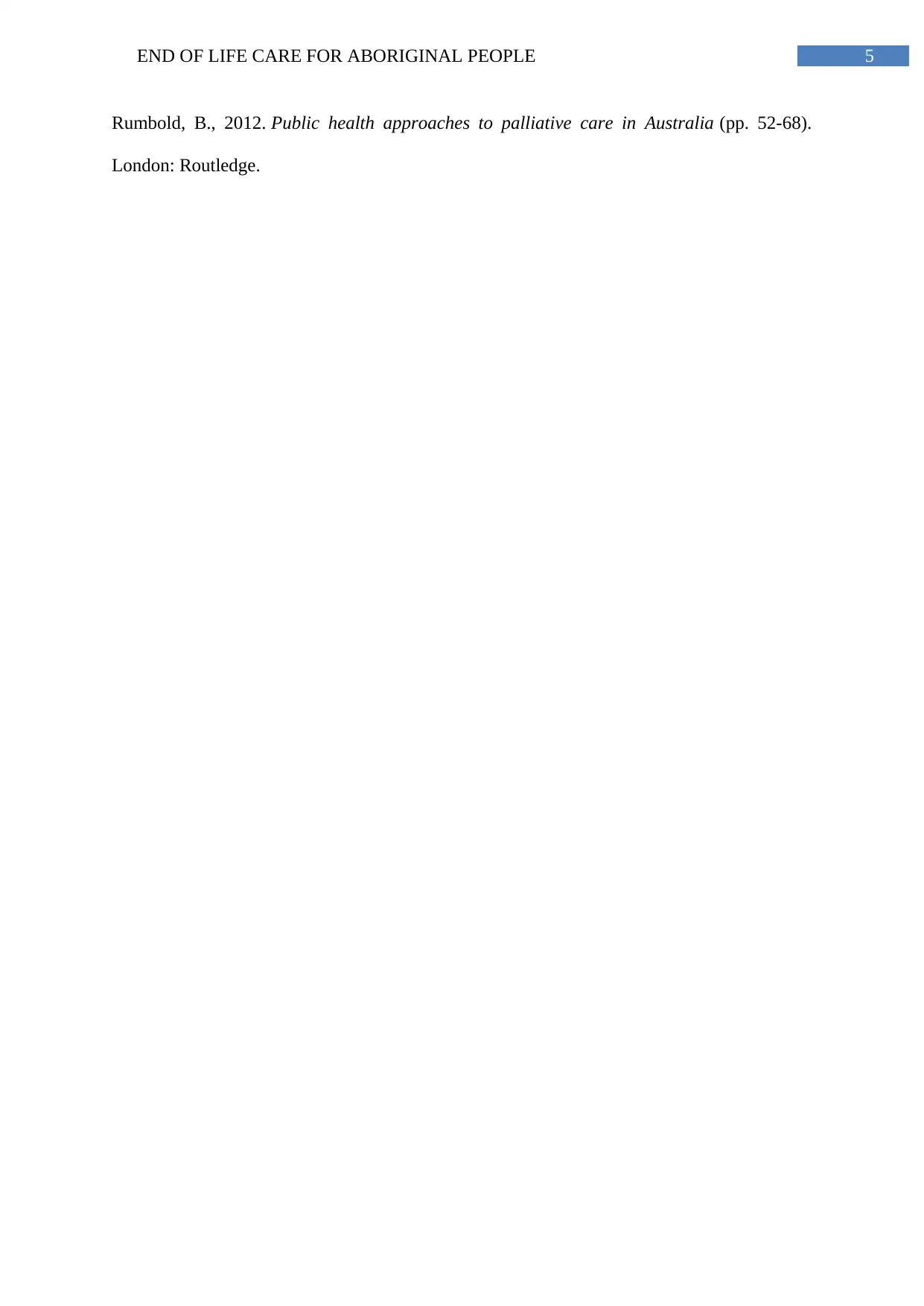
5END OF LIFE CARE FOR ABORIGINAL PEOPLE
Rumbold, B., 2012. Public health approaches to palliative care in Australia (pp. 52-68).
London: Routledge.
Rumbold, B., 2012. Public health approaches to palliative care in Australia (pp. 52-68).
London: Routledge.
⊘ This is a preview!⊘
Do you want full access?
Subscribe today to unlock all pages.

Trusted by 1+ million students worldwide
1 out of 6
Related Documents
Your All-in-One AI-Powered Toolkit for Academic Success.
+13062052269
info@desklib.com
Available 24*7 on WhatsApp / Email
![[object Object]](/_next/static/media/star-bottom.7253800d.svg)
Unlock your academic potential
Copyright © 2020–2025 A2Z Services. All Rights Reserved. Developed and managed by ZUCOL.





